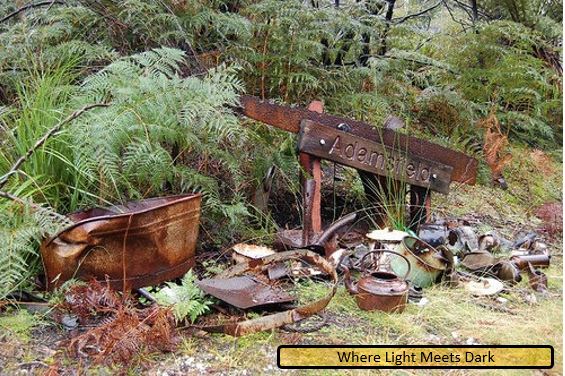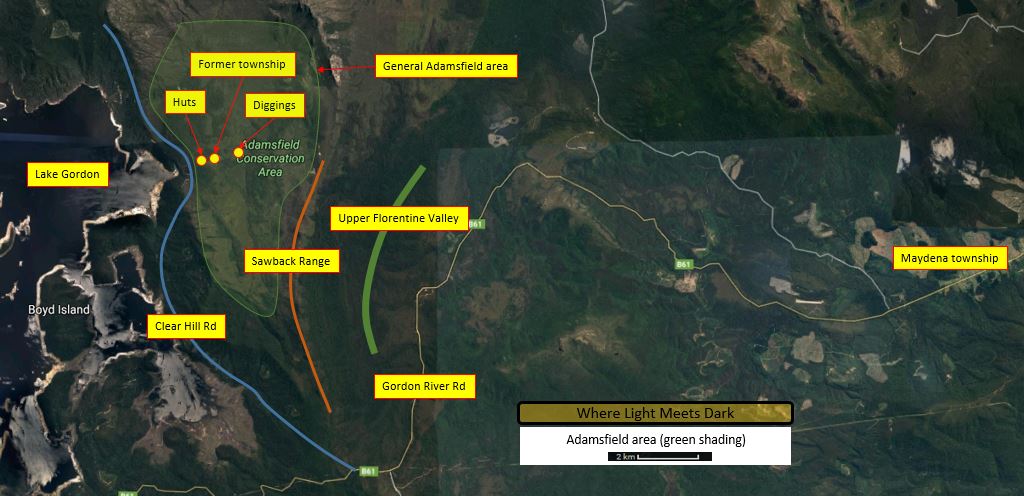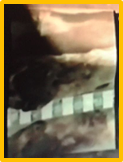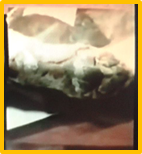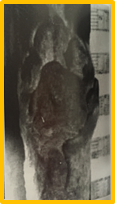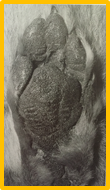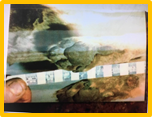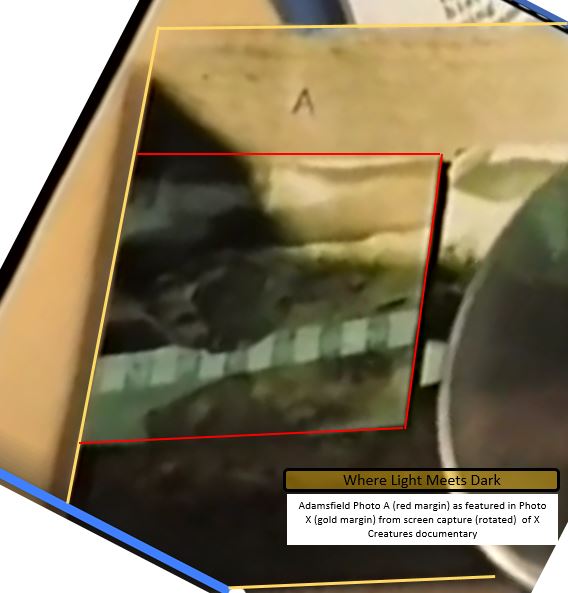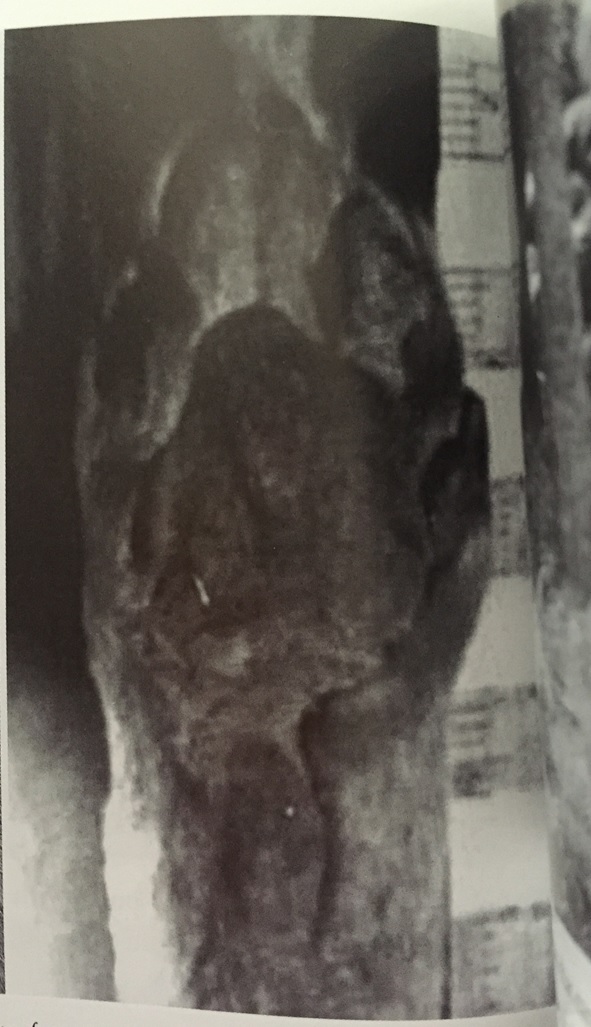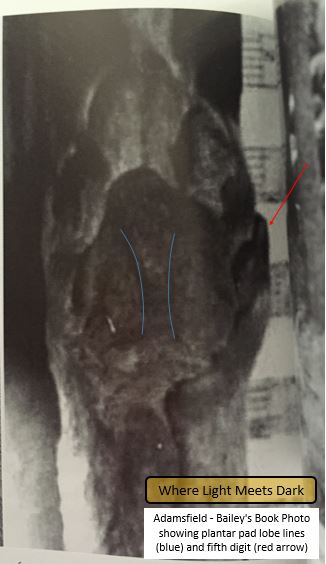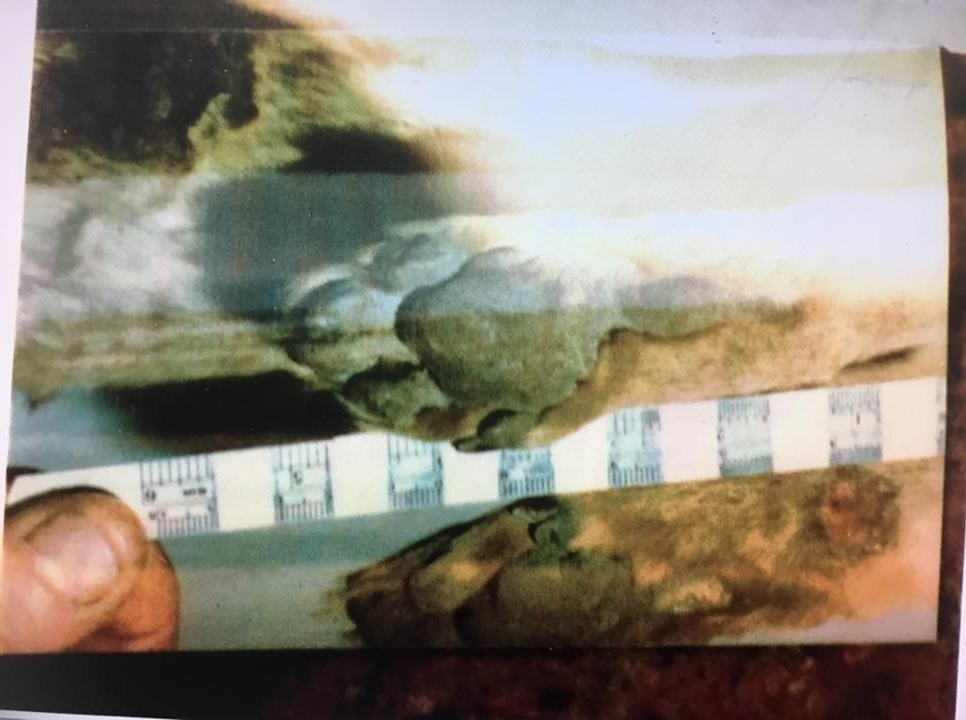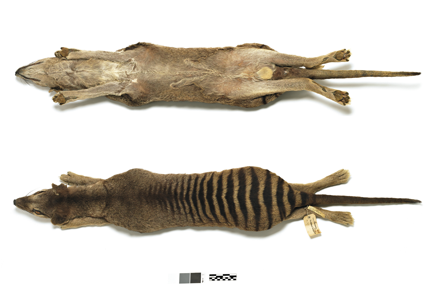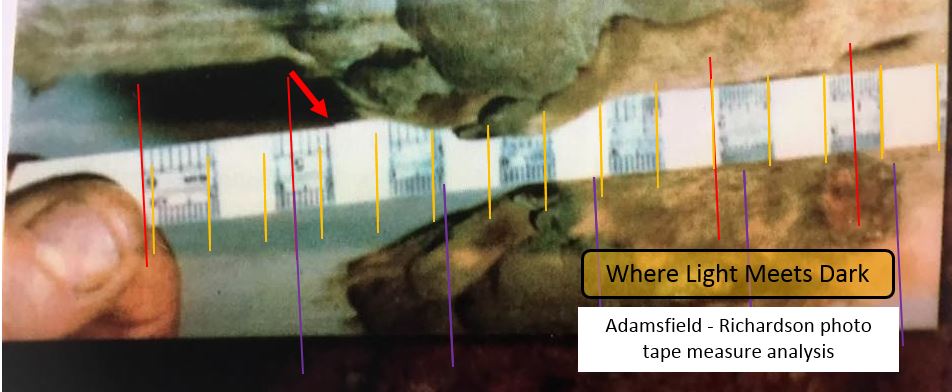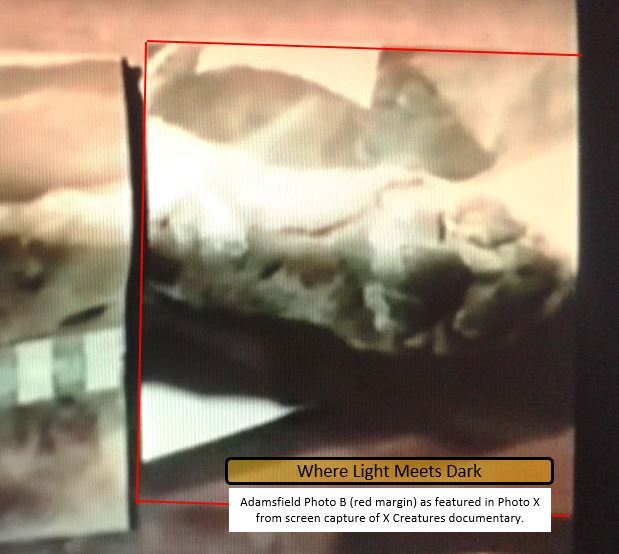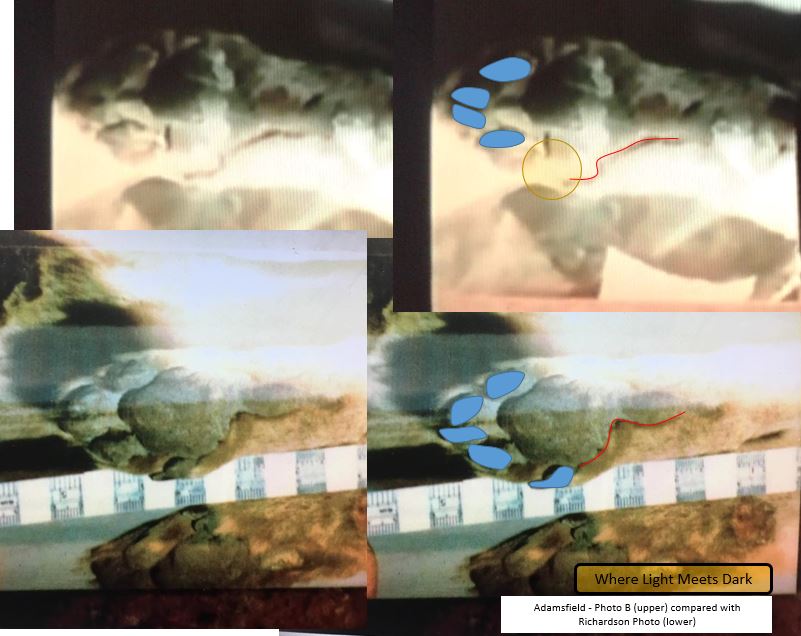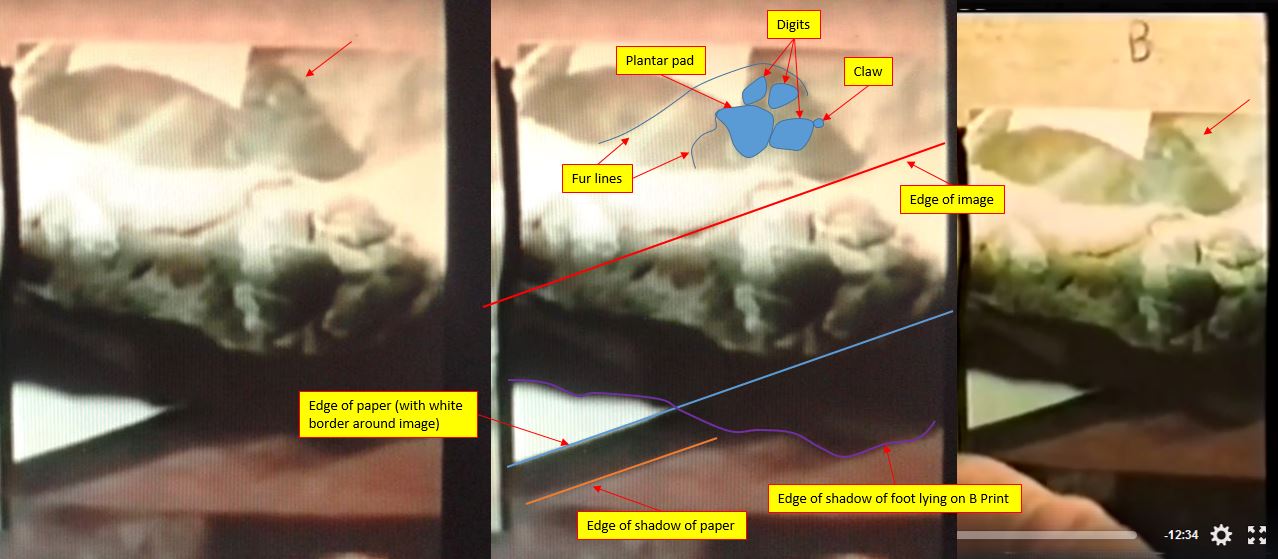Adamsfield thylacine - initial analysis
The original version of this article referred to one photo as "The B Print". Due to confusion with "Photo B", on 28 Feb 2018 this was renamed "Background Print". The name was changed again, on 1 July 2019, to "Background Photo" as it was ambiguous as to whether "Background Print" referred to "Background Photographic Print" or "Background Footprint" (the correct interpretation is Background Photographic Print).
The Background Photo can be seen within Photo B. Photo B is a photograph of a thylacine foot lying on top of the Background Photo.
Adamsfield - all that remains of the township is a sign and scattered debris
Until now, most people have spoken of "the Adamsfield thylacine" - but as we shall see in this article, the situation is almost certainly "the Adamsfield thylacines".
Introduction
The story around Adamsfield and the prospect of post-1936 thylacines there is a complex one.
At it's heart it begins with the allegation that in 1990, photographs were taken of a freshly deceased thylacine at or near Adamsfield. Where the details become murky is that there are two versions of events as to how the thylacine died (though interestingly, there is no disagreement between any of the parties involved that there was in fact a freshly deceased tiger).
Both parties remain relatively tight lipped regarding their full knowledge of events, except to say that there was a dead tiger and it was photographed.
However, when we investigate further, a rich tapestry of detail unfolds that suggests the thylacine may have persisted in the region of Adamsfield - in breeding numbers - at least until the 1990s. This would be 54 years beyond the present extinction date for the species.
In this article, it will be shown that:
- There are at least 2 and almost certainly 3 different thylacines associated with Adamsfield in the early 1990s
- All 3 are almost certainly deceased
- In all cases photographs were taken of the dead bodies or portions thereof
- In total there are approximately 10 to 16 photographs that were taken directly of the body of one or other thylacine from this group
Overview
In 2013, Tasmanian tiger reseracher and author Col Bailey published his second book, "Shadow of the thylacine". The book is an account of his lifetime's work in researching and searching for the Tasmanian tiger. It includes many stories that Col has collected over the years from people claiming to have had encounters with Tasmanian tigers.
One of these encounters is particularly notable for several reasons, and is called here the Adamsfield thylacine. Key points in Col's account are that:
- a thylacine was shot dead in 1990 at Adamsfield - a former mining town, now ghost town, and
- colour photographs were taken of the body
This account is particularly notable because of the claim of the presence of a freshly deceased body. If this were corroborated it would almost certainly be evidence enough to rewrite the history books with regard to the species' listing as extinct.
Following publication of the book, thylacine research team Thylacine Research Unit (aka "TRU") published a video interview with "Tracker Scout", aka "Rusty" a former military tracker who has spent considerable time in the Tasmanian bush. In the interview, Rusty explains how he came to take photos of a deceased thylacine near Adamsfield. Rusty's account of how the tiger died differs to that described by Bailey but notably, there is no disagreement about there having been a freshly deceased thylacine in the vicinity of Adamsfield.
This article summarises the accounts of the Adamsfield thylacine and conducts a preliminary examination of the evidence.
Map of Adamsfield Area - showing former township, huts, diggings, Clear Hill Rd, Lake Gordon, Maydena, Upper Florentine Valley and Sawback Range. Copyright: WLMD. Source map: Google Maps.
Bailey's account
Clear Hill Road sighting
Bailey's account of the Adamsfield thylacine is found on pages 171-2. He is discussing his work with a film crew in the vicinity of Adamsfield in 1999 when he notes that he has recorded much thylacine history from the area, both pre- and post-1936. "The most recent sighting [prior to being there with the film crew in 1999] had occurred only several years before along the Clear Hill Road", Bailey writes.
Clear Hill Road runs north from Gordon River Road, which is the main road through Southwest National Park. It is a logging access road and today is secured by a locked gate at its start. To the immediate west of Clear Hill Road lies Lake Gordon. To the east is a small rise, the other side of which presents an open valley with patches of scrub. The eastern side of this valley is formed by the Sawback Range and further east again lies the Upper Florentine Valley - very near to where the last thylacines captures from the wild were made.
A detailed account of the Clear Hill Road sighting is found in the online Thylacine Museum and elsewhere in the book and was taken by Bailey as one of the most credible sightings he had heard.
Adamsfield thylacine
Bailey begins the account that "then there was the tantalising photograph, alleged to have been taken near Adamsfield in 1990.
"The story goes that two men were hunting wallaby amongst the button grass when a resting animal startled them. Not realising it was a Tasmanian tiger, one of them impulsively shot the creature, only to discover its true identity.
"A series of coloured photographs were taken, and afterwards I was given the opportunity to duplicate one of them. Later investigation revelaed it to be an authentic photograph of the underbelly and feet of a freshly dead thylacine, with blood still evident on one of the animal's legs. Comparisons done with the feet of a preserved thylacine in Oxford Uninveristy in the UK have also gone some way in establishing the authenticity of the photograph.
"The feet are fresh as is the exposed ventral fur and the fact that there is a fresh graze on one hock gives the photograph enormous credibility, clearly displaying that, without doubt, this is a photo of a freshly dead thylacine. That it is a coloured print of recent origin rules out the possibility of it being taken pre-1936. It is not a digital photograph, having been taken with a standard SLR film camera. I was unable to obtain the remainder of the photos, which is unfortunate, for I believe that what I have in my possession is evidence enough to prove beyond doubt that the thylacine did indeed exist in that area, at the very least until the early to mid-1990s. This is, of course, in addition to my own sighting in March 1995 only some 20 miles to the east."
Rusty's account
As noted by TRU, Rusty "claims to have had numerous Thylacine (Tasmanian Tiger) sightings over the years in the bush in Tasmania". In the video interview, Rusty details many of these encounters. The video runs for 17 minutes and conversation turns to the Adamsfield thylacine at the 13 minute mark.
Rusty recounts "I was near a lake, out [in] the southwest and I heard that - some people said to me that they'd seen a dingo and they were [an] English couple so I naturally thought that they'd seen some sort of dog or something and took it to be a dingo. "No, there's none here" [I told them]. I had a look and found scuff marks - I went up into the rocky outcrops and everything like that and I come across a den. It had bones around it and everything, and there was a carcass of a tiger. It was a small one, you know, but striped; you could still see the stripes and everything. But, um, I took a couple of phot- I didn't take a photograph of the whole animal, I did it in sections. That was, um, geez ages [ago]."
Warren Darragh, who is interviewing Rusty, asks "You just left the carcass there?" and Rusty replies "Yeah. I've never really been interested in them. I know people are saying it'd be good if they were alive and stuff like that but I haven't really worried about it because I've seen prints. I haven't said "they are" or "they're not". I just, um - what I see is what I see."
Rusty continues "I left that area and I never went back there. I told one person what I'd found and everything and I gave him a small photograph - part thereof, you know - but, um, he made his own stories up about it, you know."
It is not explicitly stated that Bailey was the recipient of the photograph, nor even that the two men are talking of the same animal but Darragh notes that he had "subsequently had a look at that photo and to me it looked like a thylacine foot - certainly very similar to similar photos that I've seen taken of museum specimens" and Rusty affirms the comment. Given the context of this interview just a few months after Bailey's book release and that the book shows the Adamsfield thylacine foot alongside a museum specimen as mentioned by Darragh, it appears safe to assume the two men are providing differing accounts of the same animal. This would also make sense of Rusty's comment about stories being made up.
Earlier account - The X Creatures - Beyond the Jaws of Extinction
Bailey's account of events near Adamsfield was not first described in his book. In 1998 a documentary episode of "The X Creatures" was released, named "Beyond the Jaws of Extinction". In it, Bailey features and gives his version of events regarding the Adamsfield thylacine.
Chris Packham interviews Bailey and notes that he is a journalist who has collected stories from the outback, saying "in 1991, he came across this one". After noting that he has been searching for "28 or 9 years", Bailey says that after "all that time, I reckon the very best evidence I've got, to support the theory that the thylacine still lives, is in this photo here." He opens a folder from which he lifts a single colour photograph that appears to be of two further colour photographs. Bailey continues: "This came from down in the southwest of the state and it's an actual thylacine foot that was shot in 1991".
Handing the interviewer a magnifying glass, Bailey says "Now, as proof, have a look there and you'll see raw skin". The interviewer concurs "Yeah, I can see that". "So that proves that those feet are fresh - they're not a museum specimen - everything's fresh and new. Of all the field evidence that I've collected over the 28 or 9 years, that would be absolutely the best proof that I've got."
The scene switches to wilderness near Adamsfield. A vehicle crosses a river with the two huts in the background that can be seen on the road to Adamsfield. Packham recounts the story of the Adamsfield thylacine: "Two guys living out in the bush come across a dog-like animal. It opens its huge mouth, utters an eerie, shrill shreak, and they shoot it, only afterwards realising what they'd done, and this is where it happened, way off the beaten track."
Bailey explains why the habitat here is ideal for thylacines before the interviewer asks: "So Col, we've got some fantastic habitat here - ideal for thylacines - but we've just got a photograph of some feet. I can't believe the guy didn't photograph the head or body. Why is it that people are always so reticent, so secretive about their thylacine sightings?"
Col replies "Personally, if I found one I'd get my evidence and leave it [the thylacine] there and get out. But not everyone thinks the same. There are certain people who'd shoot it on sight and these are the ones the government targets when they say that they'll prosecute or even jail anyone who tries to catch, or catches, a Tasmanian tiger."
Packham concludes: "So the legal angle on this animal is complex, and it might just be helping it stay hidden. There's still suitable habitat here but there would have to be hundreds of thylacines to keep a population going."
Later clarifications
Soon after publication of the TRU interview with Rusty, Margaret Aitken, a reader of the TRU Facebook page posted, a few questions seeking clarification on the story. Her key concerns were to clarify whether Bailey and Rusty's accounts related to the same animal and whether the animal was left in its den, per Rusty's account. Several people respond with several comments, including TRU, Rusty (under the name "Russ Tyenna") and this author (Chris Rehberg, WLMD).
Key clarifications made are:
- that TRU believes Bailey and Rusty are accounting for the same, singular thylacine (per TRU's comment)
- that there were no wounds or signs of bleeding on the thylacine (per Rusty's comment)
- that Col never visited the site (per Rusty's comment)
- that when Darragh commented he had "subsequently had a look at that photo" he was referring to seeing the photo in Bailey's book (per TRU's comment)
- that Rusty had given Col a copy of the photo for reference and comment (per TRU's comment)
- that Rusty hasn't looked at the photos for a couple of decades (per TRU's comment)
- that TRU plans to visit the den site to obtain DNA evidence (per TRU's comment)
- that "the animal" (taken as meaning the Adamsfield thylacine) was full of maggots underneath (per Rusty's comment)
- that there were no bullet holes or signs of trauma (per Rusty's comment)
- that Rusty took three Polaroid photos (per Rusty's comment)
- that Rusty gave one photo to Col but held back photos of other animals, one of which Col took from Rusty which Rusty reclaimed and then destroyed, upsetting Col (per Rusty's comment)
Later again, dialogue in the Facebook group The Thylacine Open Debate and Discussion Page revealed a new instance of one of the photos seen in X Creatures. The photograph was published by Adrian Richardson in comments on a post discussing the X Creatures composite image, and shows one of the photos in more detail.
A third account
Former newspaper editor Colin Coomber of Victoria, has published an account of having inspected photographs of a freshly dead thylacine.
In 2014, soon after the broadcast of TRU's interview with Rusty, Coomber wrote "I had a stunning experience in the early 1990s when a Thylacine researcher from interstate came to Gippsland [Victoria] to investigate the many reported sightings. He produced a packet of colored photographs of a dead Thylacine which he said had been shot by hunters in Tasmania. The photographs did not just show the carcass but there were clear snaps of the head, teeth, front feet, rear feet and even of the bullet entrance and exit wounds. The hunters had taken the photographs as proof but then realised that they would be condemned for what they had done by the weight of world opinion. My informant had somehow obtained a set of the photos without the hunters knowing. With no legal right to the photos or copyright permission likely to be forthcoming, those photos have never seen the light of day. I am surprised though that after more than 20 years, these photographs have not appeared. The informant continues to track reports of Thylacines and his name crops up from time to time in the media."
Although several details align with Bailey's account (timeframe, thylacine researcher being from interstate to Victoria, photos of feet), it needs to be noted that it is not certain that this description relates to the Adamsfield thylacine.
Through personal communication with Coomber, many details were clarified regarding this account, namely:
- The photographs presented to him were not Polaroids
- They were seen in 1992
- The photos showed:
- Full shot of animal lying on its right hand side, head to the left of the print and feet towards camera. It was lying on some light tussocky grass. It appeared to have been a healthy individual, not suffering mange, and was in good condition without rib bones obviously protruding as one would expect with a sickly animal.
- There was a close up of the left side of the head, can’t remember if the eyes were open or shut. The mouth was partly open, showing some teeth and tongue.
- There was a close-up of a front foot but I did not take much notice of it.
- There was also a close-up of a rear foot which had been bent to include the long ankle bone. (Don’t know the technical term)
- A close-up of the thick tail which surprised me because it was not striped apart from one bar where it joined the hindquarters. I recall also being interested that the tail had extremely short fur, perhaps only 2-3mm long. For this photo the animal had obviously been rolled onto its belly because it was taken from above.
- That was a close-up shot of what may have been the entrance hole of a projectile. I think there was a finger or stick pointing to the mark on the fur. I don’t recall any blood being visible. There may have been.
- There was a close up of an exit wound which was larger with the fur tufted outwards. I have been a shooter and it was again a typical exit wound. Again I cannot recall seeing blood.
There were 2-3 other photos but I cannot recall exactly what part of the animal they showed.
The above descriptions give us a total of at least 7 photos and possibly up to 10 photos.
Coomber also clarified that that the photo in Bailey's book was not one of the ones he was shown and that no photo had any "measuring stick" (ie. nor measuring tape).
Examining the evidence
The primary concerns of this article are to collate what is known about the accounts of the Adamsfield thylacine and to consider the likelihood that the Adamsfield thylacine may prove persistence of the species through to 1990.
It seems apparent, especially in light of the above clarifications, that Bailey and Rusty are talking about the same, singular animal. It is possible, though not certain, that Coomber has seen photographs of the same animal.
Without seeking to clarify the differences between the accounts, we can draw a list of details that are similar between accounts, or undisputed. These form the "facts" of the matter inasmuch as the testimonies of Bailey and Rusty present them as facts. Against this understanding, we will then consider the testimony of Coomber.
Year of event - probably 1990 and possibly 1991
In the 1998 documentary, Bailey states the animal was shot in 1991. In the book published 2013, he states the animal was allegedly shot in 1990. There appears to be no statement from Rusty regarding year. It seems more likely the book reference was researched at time of writing, and is correct, and that the year quoted during filming was from memory and mistaken, although this is not proved.
- The Adamsfield thylacine was probably photographed in 1990 and possibly in 1991.
Location - near Adamsfield
Bailey reported the location as near Adamsfield in the 2013 book and took Packham to Adamsfield as can be seen by the distinctive huts in the documentary of 1998. Rusty's comment in TRU's interview was that he was near a lake in the south west. Adamsfield is in the southwest and Tasmania has hundreds of lakes including the man-made and enormous Lake Gordon impoundment which lies to the west of Adamsfield. Although Rusty doesn't confirm Bailey's reported location, neither does he contend it and Bailey's claim of Adamsfield was clearly made in the book published just prior to the TRU interview. TRU reports that in Darragh's statement of having seen the photo he was referring to Bailey's book. Note that the two huts that stand in the region today are not Adamsfield proper, which is further east and where no buildings remain. The Adamsfield osmiridium diggings are further east again, so the whole region between the huts, near Lake Gordon, to the diggings at the northern end of the Sawback Range can loosely be understood today to be the Adamsfield region.
- The Adamsfield thylacine was almost certainly found and/or photographed in the vicinity of Adamsfield
Photographs of the Adamsfield thylacine
It is when we come to considering the photographs of the thylacine that things get particularly complex.
All of the accounts of Bailey, Rusty and Coomber mention photographs. Several photographs have been published. Photographs of photographs have been taken and published. Each instance of a photograph has a story and the stories behind the photographs are not easily discerned.
In the following section a table listing all known or alleged photographs is given. Names are proposed for each photograph - for the purpose of future reference and discussion.
A list of known photographs relating to Adamsfield thylacines - with unique identifiers for each
| Photo | Naming | Depicts | Standard Orientation | Published | Year Published | Thumbnail | Thumbnail Notes |
|---|---|---|---|---|---|---|---|
| Photo A | In X Creatures, "A" was marked above this photo, presumably by Bailey. | Two feet with a tape measure between them, underside of thylacine throat in background. | Toes point toward left of frame. | On X Creatures (within Photo X, see below). | 1998 | Created by WLMD by cropping a screen grab from X Creatures. (nb. The Richardson photo depicts Photo A with more detail and in higher resolution). | |
| Photo B | In X Creatures, "B" was marked above this photo, presumably by Bailey. | One foot lying atop what appears to be a print (image) showing another foot. (This print within Photo B is named the Background Print, below). | Toes point toward right of frame. | On X Creatures (within Photo X, see below). | 1998 | Created by WLMD by cropping a screen grab from X Creatures. | |
Photo X | By WLMD, to signify this (composite) image was first published on X Creatures. | Composite image showing Photos A and B. | Photo A at left, in its standard orientation; Photo B at right, in its standard orientation. | On X Creatures. | 1998 | Created by WLMD by cropping a screen grab from X Creatures. | |
| Background Photo | By WLMD, referring to what appears to be a physical photographic print depicted lying underneath the thylacine foot shown in Photo B. | Shows the underside of another foot. | Toes point to the right of frame - as seen within Photo B in its standard orientation. | On X Creatures (within Photo B, which is within Photo X). | 1998 | Created by WLMD by cropping a screen grab from X Creatures. | |
Bailey's Book Photo | By WLMD, referring to the photo of the Adamsfield thylacine found in Col Bailey's book. | A cropped portion of Photo A, reversed (mirror imaged) and rotated 90 degrees, depicting one complete foot (showing all digits) and part of the tape measure. Presented in black and white. | Toes point toward top of frame. | In the book Shadow of the Thyalcine | 2013 | Created by WLMD by photographing the (curved) book page. | |
| Oxford Photo | By WLMD, representing Oxford University, creator of the image, but this instance, as published by Bailey. | A photograph of a foot from a preserved thylacine held at Oxford University, UK, aligned for comparison with Bailey's Book Photo. Note: the original photograph is in colour but this instance (Oxford Photo) is presented in black and white. | Toes point toward top of frame. | In the book Shadow of the Thylacine | 2013 | Created by WLMD by photographing the (curved) book page. | |
| Richardson Photo | By WLMD, to signify this image was first published by Richardson. | Photo A in higher resolution. This photo reveals that Photo A in X Creatures has been cropped at left. The Richardson photo exhibits a human thumb holding the measuring tape. | Toes point toward left of frame. Although this was first published with toes pointing right, it is proposed the standard orientation should be rotated 180 degrees to match that of Photo A published earlier. | 2018 | Created by WLMD by resizing photo published on Facebook. | ||
| Photo C1 | By WLMD, after Coomber's descriptions | Full body photograph of Tasmanian tiger lying on its right hand side, head pointing toward left of frame and feet toward bottom of frame. Animal is lying on grass and appears in good health. | Head pointing toward left of frame. | N/A | N/A | N/A | N/A |
| Photo C2 | By WLMD, after Coomber's descriptions | Left side of the head, close up, mouth partly open showing teeth and tongue. | N/A | N/A | N/A | N/A | N/A |
| Photo C3 | By WLMD, after Coomber's descriptions | Front foot, close up. | N/A | N/A | N/A | N/A | N/A |
| Photo C4 | By WLMD, after Coomber's descriptions | Rear foot, close up, bent to show long ankle bone. | N/A | N/A | N/A | N/A | N/A |
| Photo C5 | By WLMD, after Coomber's descriptions | Close-up of tail joining hindquarters, showing tail is thick with extremely short fur, and one stripe visible on hindquarters, photographed from above. | N/A | N/A | N/A | N/A | N/A |
| Photo C6 | By WLMD, after Coomber's descriptions | Probably bullet entry point with something pointing to the spot (eg. finger or stick). | N/A | N/A | N/A | N/A | N/A |
| Photo C7 | By WLMD, after Coomber's descriptions | Bullet exit wound, larger than entry wound in Photo C6, and with fur tufted outward. | N/A | N/A | N/A | N/A | N/A |
| Photo C8 | By WLMD, after Coomber's descriptions | Content not recalled. One of 2 or 3 photos in addition to Photos C1 to C7. | N/A | N/A | N/A | N/A | N/A |
| Photo C9 | By WLMD, after Coomber's descriptions | Content not recalled. One of 2 or 3 photos in addition to Photos C1 to C7. | N/A | N/A | N/A | N/A | N/A |
| Photo C10 | By WLMD, after Coomber's descriptions | Content not recalled. One of 2 or 3 photos in addition to Photos C1 to C7. | N/A | N/A | N/A | N/A | N/A |
| Photo R1 | By WLMD, after Rusty's descriptions | Content not described. Mentioned as one of "three Polaroids" allegedly taken, noting one of the three was given to Bailey. | N/A | N/A | N/A | N/A | N/A |
| Photo R2 | By WLMD, after Rusty's descriptions | Content not described. Mentioned as one of "three Polaroids" allegedly taken, noting one of the three was given to Bailey. | N/A | N/A | N/A | N/A | N/A |
| Photo R3 | By WLMD, after Rusty's descriptions | Content not described. Mentioned as one of "three Polaroids" allegedly taken, noting one of the three was given to Bailey. | N/A | N/A | N/A | N/A | N/A |
Summary of photographs
| Number | Description | Photos | Notes |
|---|---|---|---|
| 3 | Seemingly verified direct photos of a thylacine (excluding Oxford Photo) | Photo A; Photo B; Background Photo (assuming thylacine) | |
| 6 | Published versions of photos seemingly verified direct photos of a thylacine (excluding Oxford Photo) | Photo A; Photo B; Photo X; Background Photo (assuming thylacine); Bailey's Book Photo; Richardson Photo | |
| 16 | Distinct photos allegedly of a thylacine (excluding Oxford Photo) - possible maximum | Photo A; Photo B; Background Photo (assuming thylacine); C1 - C10; R1 - R3. | Assuming there were 3 photos in addition to the 7 Coomber recalled. |
| 13 | Unpublished alleged photos (possible maximum) | C1 - C10; R1 - R3 | Assuming the one photo Rusty notes as given to Bailey has not been published. |
Analysing published photographs
Photo A and its variations
Photo A appears:
- Within Photo X
- Cropped, as Bailey's Book Photo
- As the Richardson Photo
These three are shown below.
Photo A as seen within Photo X - Source: Youtube. Credit: Unknown.
From this source, little detail is seen. One foot is shown fully, at centre of frame. A second is shown partially cropped, along bottom of frame. Between the two there is a tape measure of some kind.
Other versions of Photo A offer more information about the photograph's content. However Photo X shows us that Photo A is laid alongside Photo B on some surface. The surface above the two photos is tan in colouration and has some marks. The surface below the photos appears darker and more textured. (The large curved object at right of this image is a magnifying glass being used in the documentary to examine Photo X).
Photo A as seen in Bailey's Book Photo - Source: Bailey, Shadow of the Thylacine. Credit: Unknown.
Note that this is a photograph of the book page. As such there is some distortion here - visible along the top and bottom edges of the page. Note the following page is visible in this image along the right edge. The edge of Bailey's Book Photo runs along the tape measure that is visible.
Note also that in addition to having been rotated 90 degrees (with respect to our view of Photo A in Photo X in X Creatures), the photo is also reversed; that is, mirror-imaged. This makes a detailed analysis of the content of Bailey's Book Photo difficult, without first orienting it (and reversing it again) to match Photo A as seen in Photo X. Nevertheless, without comparing this image to others at this point, several features are visible and worth mention.
This photo provides a higher resolution depiction of the foot that is at centre frame of Photo A. Bailey presents this depiction alongside the Oxford Photo for the purpose of illustrating the similarity of the foot to a verified thylacine specimen. This author concurs the foot in Photo A is that of a thylacine.
Four digits are clearly seen and the fifth claw is visible at the right edge of the foot, over the tape measure. Having five digits makes this a thylacine forefoot. Note the generally rounded appearance of the plantar (palm/hand/main) pad. Two near-vertical lines may be seen, dividing the plantar pad into three lobes - also characteristic of the thylacine forefoot. The exposed skin extends back behind the plantar pad (toward bottom of frame) without any fur covering.
The tape measure can be seen to have black and white markings. The black markings appear faded and seem to have darker lines imposed upon them.
Bailey's Book Photo - illustrated to show the lobe lines on the plantar pad (blue) and the fifth digit (red arrow). Illustration: WLMD. Source Photo: Bailey, Shadow of the Thylacine. Photo Credit: Unknown.
Photo A as seen in the Richardson Photo - showing a tape measure being held between two thylacine forefeet and with the underside of neck fur in the upper background. Source: Facebook. Credit: Unknown.
Note: The photo was originally published rotated 180 degrees from how it is presented here. It has been rotated here in order to orient it the same way as seen in the earlier publications of this image (Photo X; Bailey's Book Photo).
This is clearly the best resolution of this image available and contributes to our understanding of the contents of Photo A. Key things to note:
- The foot at centre of frame is the one included in Bailey's Book Photo.
- The five digits on that foot are unambiguous here.
- The foot at bottom of frame has a wound at the bottom-right corner of the frame.
- This wound is mentioned by Bailey in X Creatures, to Packham, the interviewer, who agrees the wound looks fresh.
- There is a black mark on the other foot, across from this wound. That mark may be dried blood from rubbing against the wound but this is not certain.
- The foot at the bottom of frame also shows either an unusual second digit (after the thumb claw), or possibly a tuft of fur obscuring the second digit.
- Thylacines are known to have fur extending down past the digits.
- The end of the tape measure is partially visible and is rounded.
- The markings on the tape measure are more legible but seem unusual (discussed below).
- The thumb holding the tape measure is visible.
- The upper half of the frame shows fur. This is the underside of the animal's neck/chest/throat area. There is a comparable image of a specimen skin housed at the Smithsonian, photographed from a similar angle which can help to visualise how this photo has been taken (see below).
Smithsonian specimen USNM125345 - showing similar posture to Photo A, in upper half of image. Photo: National Museum of Natural History Photographic Services via Penn State University website.
The Smithsonian specimen is photographed looking directly down at the ventral surface. In photo A the thylacine appears rolled toward the camera, providing an oblique, but reasonably similar angle of view.
Returning to the unusual markings on the ruler, reading the measure from left to right, we see the following numerals:
first black mark = 6
second = 5
third = ??
fourth = ??
fifth = ??
sixth = 2 (which doesn't add up)
seventh = 1
eighth is just barely visible.
The black marks are not marks, per se. Rather, the *white* portions between the marks appear to be white tape wrapped around a ruler (not tape measure).
Illustration of the Richardson photo - tape measure analysis - Illustration: WLMD. Source Photo: Facebook. Source Photo Credit: Unknown.
In the illustration above, note the red arrow - this shows a bump on the edge of the measure, correlating with the end of a dark section and is consistent with the white section being formed by wrapping white tape around the measure.
If this is the case, we can see at the thumb that the left end is the end of the measure. The numeral at that end is 6. It is concluded that rather than being a tape measure, this is in fact a ruler of 6 inches length. The white tape is applied at 1cm intervals, thus obscuring the ruler's own markings. Where there is no tape, we see the inch markings - hence the numerals not corresponding to the number of black markings seen, and hence the numerals appearing in different places on each of the black markings.
To verify the theory, first two red lines were applied at left - over the 6 and 5 inch points. These were replicated in purple, below the ruler and spaced evenly. Where we expect these inch-wide marks to overlap with the 2 and 1 numerals, they do not. Despite this, it is concluded that these are still equal inch markings but that the ruler is sloping downward, toward the right of frame. (Consider standing on railroad tracks and viewing the sleepers which lie under the tracks. The sleepers near you will be a considerable distance apart, but further away from you they will appear closer together.)
Secondly, the same exercise was carried out with the white tape markings, but starting from the right hand side. They also did not accurately align at the other end of the ruler which is consistent with the inch markings. In brief, both the ruler's markings and the tape markings were affected similarly by the slope of the ruler.
- It can be concluded this is a 6 inch long ruler with 1cm wide tape markings (and spacings)
The above also allows us to estimate the lengths of the feet, plantar pad, digits, etc. although a detailed analysis is not included here.
- An approximation of the plantar pad length is 2.5 to 3.5 cm, depending on interpretation of the posterior edge
Photo A conclusions
In the opinion of this author, Photo A (via its derivatives) shows beyond reasonable doubt the forefeet of a thylacine.
- The plantar pads are well hydrated.
- The right manus (hand) shows a circular wound on the inside of the wrist.
- This wound appears fresh.
- The right manus 2nd digit (index finger) appears at an odd angle, or, a tuft of fur is seen obscuring the second digit.
In the opinion of this author, the appearance of the wounds is inconsistent with a preserved specimen and is likely indicative of a freshly deceased animal.
Further,
- The measure in the photo is a 6 inch ruler, marked in inches, but obscured by white tape of 1cm widths spaced at 1cm intervals (ie. 1cm between each instance of tape).
- A thumb can be seen holding the end of the ruler.
- The ruler allows us to calculate an initial estimate of the left plantar pad length at 2.5 to 3.5cm.
Photo B
Photo B appears to show another foot with a variety of detail around this foot which is here analysed further.
Photo B as seen within Photo X - Source: Facebook. Credit: Unknown.
Photo B is perhaps the most interesting of all photos analysed so far.
Where Photo A establishes the identity of the animal as a thylacine, and goes so far as to suggest fresh wounds implying a freshly deceased thylacine, Photo B is actually suggestive of there being a second thylacine.
It needs be stated that the foot which appears in this photo is presumed to be from the same animal as the foot that appears in Photo A. While this is not proveable from the images themselves, there is nothing to suggest otherwise, and that appears to be the testimony presented by both Bailey and Rusty when they confirm multiple photographs taken from a single animal and when Bailey presents Photo X to X Creatures.
The first consideration is to identify the foot that appears in this photo - whether it is thylacine, and which foot it is. To this end, the composite below lays out the three feet visible in the two photographs A and B, in the same orientation. As the Richardson photo is the best quality available for Photo A, that is used in this comparison.
Illustration showing Photo B (top row) compared with the Richardson Photo (bottom row) - Illustration: WLMD. Photo B and Richardson Photo Source: Facebook. Photo B and Richardson Photo Credit: Unknown.
In this comparison Photo B is at top and rotated to match the orientation of the Richardson Photo (toes point toward left of frame). The red line on the Richardson Photo (bottom) traces the edge of the fur along the plantar pad. The red line on Photo B (top) is interpreted to likewise trace the fur line. The shapes differ markedly, suggesting Photo B is not of the left manus (forefoot) in Photo A. Likewise, that left manus in Photo A (via the Richardson Photo) clearly shows a thumb digit. This would be expected at the orange circle in Photo B but is not there.
The blue marks show where digits are visible. In Photo B, the uppermost digit is an approximation. If Photo B were the right manus of the same animal we should expect to see a thumb at the top edge of the plantar pad, and we should expect to see the wound in a similar position to that seen in the Richardson Photo. While these are suggestive, the resolution is not quite sufficient to make this a firm conclusion. It is also conceivable that Photo B shows a hind foot as only four digits are prominent and thylacines have only four digits on the hind foot. A hind foot is perhaps likely, as a complement to Photo A documenting the forefeet.
Regardless of whether this is a fore or hind foot, sufficient detail exists to show the foot is consistent with the key features of a thylacine foot. However, due to the lower resolution, the identification cannot be firmly established.
As noted in the summary of photographs, Photo B appears to show yet another photo - lying underneath the foot. This photo was named the Background Photo in the list above. The illustration below outlines the edges of this additional photograph and traces the key features of the foot in that photograph.
Photo B conclusions
In the opinion of this author, Photo B possibly shows a thylacine foot but the resolution of the image is insufficient to establish a firm identity.
- The foot does not appear to match the left manus of Photo A
- The foot may match the right manus of Photo A
- The foot may be a hind foot and this seems more probable
Further, Photo B contains an impression of a further photo, named the Background Photo, which is analysed below.
Background Photo as seen within Photo B
The Background Photo is not immediately obvious on examining Photo B. Firstly, we do not have any standard image of Photo B. Any rendition of Photo B is necessarily a screen capture taken from the X Creatures documentary. In the documentary, Photo X was handled, examined under a magnifying glass and filmed from different angles. It is from this source that we derive screen captures showing Photo B. The Background Photo is, in this author's opinion, a photographic print lying underneath the foot depicted in Photo B. This is best demonstrated through illustration.
Illustration demonstrating the presence of the Background Photo - Illustration: WLMD. Photo Sources: X Creature. Photo Credits: Unknown.
In this illustration, two different screen captures of Photo B are used - at left and right. The left capture is reproduced at centre. The red arrows on the left and right captures point to the location of the foot appearing in the Background Photo.
In the centre capture, several elements are illustrated. First, the blue line marks the paper's edge of the Background Photo. This is seen at the left end of the blue line. Second, the red line marks the edge of the printed image on this paper. This is seen at the right end of the red line: above the line, imagery can be seen; below the line is white. This white forms a margin around the illustration. Third, the orange line shows the edge of the shadow being cast by this piece of paper. Fourth, the purple line shows the shadow being cast by the thylacine foot - first across the paper (at left), then across the bench or surface on which the foot (and the paper underneath the foot) is lying. This being the interpretation of the straight lines and shadows, then the imagery seen above the red line is interpreted to be a photograph. Further, this photograph appears to show yet another foot. The plantar pad, digits and one claw are illustrated in blue and labelled. Two "fur lines" are labelled. The top fur line is interpreted as the edge of the foot. The lower fur line is interpreted as the edge of the portion of unfurred skin posterior to the plantar pad (similar to what is seen on the thylacine foot lying atop the Background Photo).
It can be demonstrated (not shown here) that the white margin on the Background Photo does not originate with a Polaroid camera. Specifications for the print sizes and their margins, for the three Polaroid models available at the time of these events, are known. For each margin, the ratio between its width and length can be calculated. In the Background Photo, if the distance between red and blue lines is taken as the width of a margin, extrapolating the expected margin length using the ratios shows that the Background Photo cannot be a Polaroid due to the margin being either too short or too long, depending on the margin being evaluated in the specifications.
Identifying the Background Photo animal
A portion of the foot is obscured by the curved white shape at the top edge of the image. The lower edge of the foot is also obscured - this time by the thylacine foot lying atop the Background Photo. As such, it cannot be determined whether any thumb digit is present in the Background Photo. Although only three digits are visible is seems likely there should be a fourth, out of view. While the plantar pad is small and appears to match that of a domestic cat, the presence of a visible claw is unlikely for a cat, given cats have retractable claws (and assuming this is not a tuft of fur). The layout of the digits does not follow the typical canine layout but rather appears to circumscribe an arc in the manner of several marsupials, including the thylacine. Identification of the animal cannot be certain, for the same reasons as for Photo B - the image is too low resolution to provide sufficient diagnostic information. However thylacine remains the strongest candidate on the grounds that:
- A cat is unlikely to exhibit a claw
- A dog is unlikely to have digits circumscribing an arc
- No visible feature is inconsistent with thylacine
The foot lying atop the Background Photo is possibly a thylacine. It has been presented (by Bailey) as being from the same animal as shown in Photo A and the animal in Photo A is shown in this article to be thylacine. The fact that the foot in Photo B is lying atop the Background Photo may suggest that the animal in Photo B was being compared with the animal in the Background Photo. An examination of the two screenshots at left and right in the illustration above, of the two feet side by side, shows a fair similarity between the two feet.
On the basis of the consistency of the testimony of those presenting Photos A and B as evidence of a thylacine (Bailey and indirectly, Rusty), and the demonstration of Photo A to depict a thylacine, and the extension that Photo B likely shows a thylacine, and the positioning of the Photo B foot atop the Background Photo (as if for comparison), and the recognisable similarity between the feet of Photo B and the Background Photo, and the visibile features of the foot in Print B which seem incompatible with cat or dog, this author concludes that the animal in Print B is possibly also, and even likely also, to be a thylacine.
Implications of the Background Photo
If the animal in the Background Photo is taken to be a thylacine, it begs the question of whether it is the same thylacine as depicted in Photos A and B. Without rigorous analysis, by general comparison, it seems sufficiently different than all of the feet seen in Photos A and B to suggest it is not the same animal. The width of the plantar, with respect to the width of the furred portion behind the planter, suggests the animal in the Background Photo either has a longer coat of fur or a relatively smaller plantar pad to ankle width. That being the case, if we assume the three feet visible in Photos A and B come from the same animal, it is unlikely the Background Photo foot represents the fourth foot of that animal.
Further, for the Background Photo to depict the same animal, this would require the animal to be photographed, that photograph to be processed (at a time - assuming 1990 to be correct - when film photography was the norm and development of the film at a lab would almost certainly be required) and printed, and then for that print to be brought back to the animal for the purpose of taking Photo B.
It seems far more reasonable to conclude the animal in the Background Photo is not the animal in Photos A and B but rather, that the animal in Photo B was laid atop the Background Photo for direct comparison. This being the case, if the animal in Photo B is taken as a thylacine, this strengthens the case for the animal in the Background Photo to also be a thylacine - it seems unlikely a thylacine would be laid atop an image of a cat or dog for comparison.
However, this rationale does assume the positioning of the animal in Photo B over the Background Photo is for the purpose of comparison and not, for example, coincidental, with a photograph of some other animal happening to lie on the same table. It seems unlikely that the thylacine being photographed in Photo B would be laid on a table cluttered with a random photograph, and further, even less likely that that photograph should happen to show an almost identically shaped and oriented foot. The unlikelihood of such coincidences also strengthens the argument for the animal in the Background Photo being a thylacine and not the same one as in Photo B.
That being the case, the question is asked - what thylacine is being depicted in the Background Photo? Is it a known image from a reference - such as a taxidermied specimen? There is very little to go on, within the image, to draw any suggestion as to the origin of the animal in the Background Photo.
Background Photo conclusions
In this author's opinion the Background Photo shows the foot of what is likely to be a thylacine, especially if Photo B shows a thylacine. The conclusion is drawn largely based on the associations between the Background Photo and Photo B, and between Photo B and Photo A as accounted for by inspection and by Bailey and Rusty. With the minimal detail available, a reasonable similarity to the foot in Photo B is noted. It seems likely the foot in Photo B was being compared with the foot in the Background Photo.
Analysing unpublished photographs
The Coomber photos
Without published copies of the photographs themselves, it may be tempting to dismiss this account as evidence. However, in courts of law, historical events are routinely understood through the collation of witness testimony and indeed, often photographic evidence is nonexistent.
In this case we have the testimony of a newspaper editor giving an account of what was presented to him. Being a journalist, he is likely to be quite familiar with photography and the varying photographic formats. Coomber noted that the photographs were not Polaroids and thus inconsistent with the photographs mentioned by Rusty. He also noted that although he saw photographs of both front and rear feet (or one of each foot) none of the photographs showed any measuring device of any sort. He noted the animal's body lay on tussocky grass; the animal in Photos A and B is lying on a flat surface, as far as can be seen.
In this regard, all the details of Coomber's account suggest that the photo set he witnessed did not include either of Photo A or Photo B. For Coomber to have seen the same animal it would seem that a substantial set of photographs would have to have been taken in the field followed by additional photographs taken on a flat surface.
In this author's opinion the animal in the Coomber photographs is a thylacine, based on the detailed descriptions and, on balance of probability, is not the same one as in Photos A and B.
Although Coomber confirms the photos are alleged to have originated in Tasmania, no more specific location was recounted. That is, it is unknown whether the Coomber animal originated from Adamsfield. As noted however, the evidence was presented to him in 1992, reasonably coinciding with events at Adamsfield.
Rusty's photos
Without published copies of the photographs themselves, it is difficult to determine which of Rusty's photos, if any, relate to the photos presented in X Creature and Shadow of the Thylacine. In clarifications, Rusty noted that his photographs were Polaroids. None of the published images appears to have been produced with a Polaroid camera. The Coomber photos also appear not to have been produced with a Polaroid. Rusty did note giving one photograph away and later clarified this was given to Bailey but such a (Polaroid) photograph remains unpublished. Without detailed descriptions of the content of the Polaroids, no firm conclusions can be drawn about these photographs.
Counting thylacines
In this article it was seen that there is evidence and testimony to account for up to three distinct thylacines between 1990 and 1992.
| Thylacine | Supporting evidence | Origin of animal | Species identification | Likelihood evidence suggests an animal living within one thylacine lifespan of 1990 |
|---|---|---|---|---|
| 1 | Feet clearly shown in Photo A and likely in Photo B | Adamsfield alleged by Bailey | Likely | Likely, on the basis of Photo A if the dates reported by Bailey are accurate. |
| 2 | The Background Photo and its association with Photo B | Not known, but associated with the thylacine allegedly from Adamsfield via that thylacine (in Photo B) being compared with this one. | Possible | Not knowable without knowing more about the origin of the animal and/or photograph. |
| 3 | The Coomber Photos | Tasmania alleged | Likely | Likely if the dates and testimony reported by Coomber are accurate.* |
Author's note: There is nothing in personal communication with Coomber to suggest anything regarding his testimony is inauthentic.
Note: The thylacine in the Background Photo may also be the one in the set of photos seen by Coomber, reducing the number of thylacines to 2 and suggesting the person producing Photos A and B had access to the photos seen by Coomber. On enquiring with Coomber about this possibility, he noted that he did not recall specifics of the foot photo but did not believe this was one of the photos he had seen.
Conclusion
The allegation that there was a recently deceased thylacine originating from near Adamsfield in 1990 or 1991 has been public since at least 1998. At that time a single photograph was presented to a documentary film crew. That photo depicted two further photos - A and B. These photos depict animal feet and it was alleged that a wound visible on one of the feet supports the claim that the animal was freshly dead.
In 2013 one of these images was presented again - Photo A - in mirror image. The purpose of this publication was for comparison with a verified thylacine specimen foot. The identification of the foot in Photo A as a thylacine was compelling on the basis of this comparison. However the provenance of the photograph remained a mystery, although the same account given in 1998 was repeated.
Later in the same year a second account of the origin of this animal came to light. While details on how the animal came to be deceased and photographed differed, the key element in common was the agreement that there was a freshly deceased Tasmanian tiger in 1990.
In 2014 a third account of a recently deceased thylacine from Tasmania came to light. It was not clear at that time whether this account was of the same animal of Photo A.
In 2018 a higher resolution version of Photo A was made available. This again affirmed the identification of the species in Photo A as thylacine.
In this article a thorough comparison has been made between all of the published photographs. Further information relating to the third account has been described. New insights gained include:
- That Photo B depicts a portion of a further photograph, now named the Background Photo
- That the Background Photo depicts a foot and this seems likely to be thylacine on the basis of the accounts given and the relationship of the Background Photo to Photo B
- That the measure in Photo A is almost certainly a 6 inch steel ruler with white tape banding at 1cm intervals
- That the photographs witnessed by the newspaper editor almost certainly depicted a thylacine
- And that altogether there appear to have been 3 deceased thylacines photographed - with the relationships between each (if any), unknown.
In this author's opinion:
- the identity of the animal in Photo A is thylacine, beyond any reasonable doubt.
- the combined testimony of Bailey and Rusty presents a compelling case that Photo A was taken in 1990 or 1991 and that the animal in that photo originated near Adamsfield.
- there is significant further evidence to suggest there may have been at least a second thylacine recently deceased in about 1990 or 1991 in Tasmania (the Coomber evidence) and possibly a third (the Background Photo but with provenance unknown).
- The thylacine in the Background Photo may also be the one in the set of photos seen by Coomber, reducing the number of thylacines to 2 and suggesting the person producing Photos A and B had access to the photos seen by Coomber.
Revisions
- 9 Jan 2018 - note that the Background Photo may be one of the images seen by Coomber; later same day, added clarification from Coomber that he did not think it was.
- 28 Feb 2018 - renamed 'The B Print' as 'The Background Print' to distinguish it from 'Photo B' and included note at top advising of same. One typo additionally corrected.
- 1 Jul 2019 - renamed 'Background Print' to 'Background Photo' to avoid ambiguity between 'Background Photographic Print' and 'Background Footprint' (the correct interpretation is Background Photographic Print) and updated the note at top advising of same.
- 29 Apr 2023 - renamed article from "Adamsfield thylacines" to "Adamsfield thylacine - initial analysis" and moved the article location within the website, to be placed under a new page titled "Adamsfield thylacine" (rather than being the root page for articles relating to this subject).
